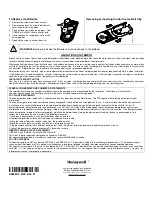
To Replace the Batteries
1. Remove the screw from the back case.
2. Remove case back by using the blade of a
small screwdriver to pry open.
3. Place batteries as shown on diagram. Use
CR2430 or DL2430Lithium batteries only.
4. Close the case by snapping case front and
back together.
5. Replace the screw to secure the case.
Removing or Inserting the Unit from a Belt Clip
5404BD
V
-002-V0
!
WARNING!
Improperly installing the batteries will cause damage to the batteries.
LIMITATIONS STATEMENT
Signals sent by wireless transmitters may be blocked or reflected by metal objects before they reach the alarm receiver. Even if the signal path has been
recently checked during a weekly test, blockage can occur if a metal object somehow blocks the signal path.
Wireless button type transmitters that have visual and audible indications of status must be used to confirm that the desired action (such as arming) has
occurred after pressing a function button on any of these transmitters. Be sure to listen for appropriate audible and visual indications that such action
has occurred. Otherwise, you could inadvertently leave yourself or your premises unprotected.
External factors such as humidity, high or low temperatures, or constant activation of a programmed button may reduce battery life in a given installation.
If the button unit is used infrequently, activate it regularly (once per week) to confirm operation. A button type transmitter will report a low battery
condition to the alarm control when a low battery status is detected.
IMPORTANT SECURITY NOTICE
Your key fob is similar to your keys or access card. If lost or stolen, another person can compromise your security system. Immediately notify your
Dealer/Installer of a lost or stolen key fob. The Dealer/Installer will then remove the key fob programming from the security system.
FEDERAL COMMUNICATIONS COMMISSION STATEMENTS
The user shall not make any changes or modifications to the equipment unless authorized by the Installation Instructions or User's Manual.
Unauthorized changes or modifications could void the user's authority to operate the equipment.
FCC CLASS B STATEMENT
This equipment has been tested to FCC requirements and has been found acceptable for use. The FCC requires the following statement for your
information:
This equipment generates and uses radio frequency energy and if not installed and used properly, that is, in strict accordance with the manufacturer's
instructions, may cause interference to radio and television reception. It has been type tested and found to comply with the limits for a Class B
computing device in accordance with the specifications in Part 15 of FCC Rules, which are designed to provide reasonable protection against such
interference in a residential installation. However, there is no guarantee that interference will not occur in a particular installation. If this equipment does
cause interference to radio or television reception, which can be determined by turning the equipment off and on, the user is encouraged to try to
correct the interference by one or more of the following measures:
• If using an indoor antenna, have a quality outdoor antenna installed.
• Reorient the receiving antenna until interference is reduced or eliminated.
• Move the radio or television receiver away from the receiver/control.
• Move the antenna leads away from any wire runs to the receiver/control.
• Plug the receiver/control into a different outlet so that it and the radio or television receiver are on different branch circuits.
• Consult the dealer or an experienced radio/TV technician for help.
INDUSTRY CANADA CLASS B STATEMENT
ICES-003 Class B Notice - Avis NMB-003, Classe B
This Class B digital apparatus complies with Canadian ICES-003.
Cet appareil numérique de la classe B est conforme à la norme NMB-003 du Canada.
FCC / IC STATEMENT
This device complies with Part 15 of the FCC Rules, and RSS 210 of IC. Operation is subject to the following two conditions: (1) This device may not
cause harmful interference (2) This device must accept any interference received, including interference that may cause undesired operation.
Cet appareil est conforme à la partie 15 des règles de la FCC & de RSS 210 des Industries Canada. Son fonctionnement est soumis aux conditions
suivantes: (1) Cet appareil ne doit pas causer d' interferences nuisibles. (2) Cet appareil doit accepter toute interference reçue y compris les
interferences causant une reception indésirable.
ÊK3636V3fŠ
K3636V3 9/04 Rev. B
2
2 Corporate Center Drive, Suite 100
P.O. Box 9040, Melville, NY 11747
Copyright © 2009 Honeywell International Inc.
www.honeywell.com/security




















